
After Impresionism - from Pointillism to Cubism
A short history of French Art - 7.
About-France.com
- the connoisseur's guide to France
1886-1910 - The way towards Cubism: Pointillism, les Nabis, les Fauves and others
Moving on from Impressionism
The last Impressionist Exhibition was held in Paris in 1886; by then, even newer paths to artistic innovation were already opening up.It was but a short step from the Impressionist experimentation with light and perception, to experimenting with the concept of colour itself. By the late 19th century, advances is printing had shown how it was possible to print any colour using a combination of three primary colours, and painters were keen to experiment further. Impressionist art had already understood that colours could come to life and seem brighter if painted not as flat surfaces, but as contrasting brushstrokes and dabs of paint; but in this they had just opened the door. There was much more exploring still to be done.
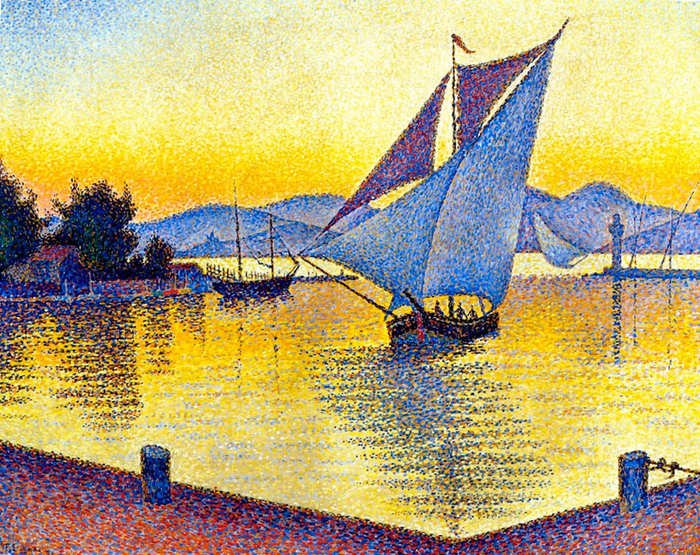
Paul Signac - The port of
St. Tropez at Dusk - Tokyo, Museum of western art.
Pointillism and Post-Impressionism
Between 1890 and the First World War, artistic life in France was moving forward as never before. By 1890, moving on from Impressionism, Pissarro had begun to experiment with the way he rendered light and colour, by breaking them up into their constituent parts, or constituent colours, in the way that colour-dot printing has since generalised. He was not the only one.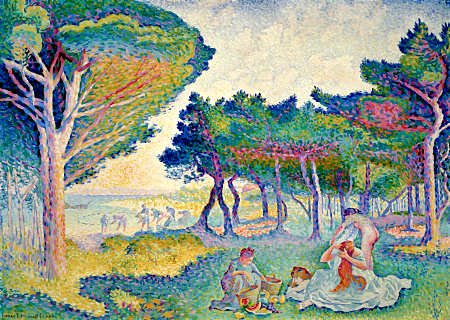
Henri Cross - Bathers
One of these was Vincent van Gogh, a Dutch artist born in 1853, who moved to France at the age of 33 to be with his younger brother Theo, an art dealer in Paris. Thanks to Theo, Vincent van Gogh met Pissarro, Gauguin, Seurat and others, and was instantly inspired by the new art, taking it up and adapting it in his own

Vincent Van Gogh - night sky
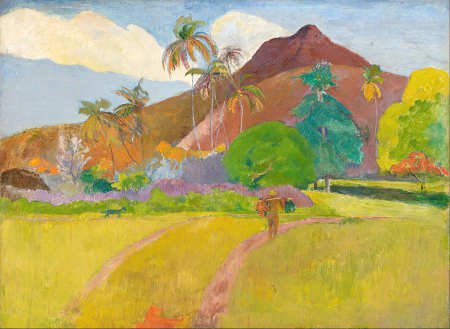
Gauguin - Tahiti landscape - Minneapolis Art gallery
At first he experimented with a kind of pointillism, as can be seen in some of the earlier paintings from his French period including his reinterpretation of Millet's Sower and some of his self portraits. But soon after he developed an unmistakably personal style imparting a sense of movement and vibration into a picture by the use of bold brushstrokes, with dabs and swirls of bright colour, in a way that is most commonly referred to as "Post-Impressionist".
Two other artists who further innovated in the use of bold colour were Gauguin and Matisse. For a short period in 1888 van Gogh and Gauguin lived together in the Provencal town of Arles, where they had gone to seek out the intense light and shade of Mediterranean France. Their joint venture in Arles ended in a fiery argument during which van Gogh, who drank too much and had long been suffering from instability, cut off his own ear with a razor. In 1890, van Gogh took his own life.
Gauguin painted in a very different manner from van Gogh. In 1877 he had met Pissaro and been influenced by the Impressionists, actually exhibiting with them in the Impressionist exhibitions in Paris in 1881 and 1882. Later he moved on to a more personal style, producing pictures inspired by the imagination, and using large expanses of colour. Eventually, his search for inspiration in light and colour took him beyond the Mediterranean, and he travelled to Tahiti in search of a pure and colourful environment.
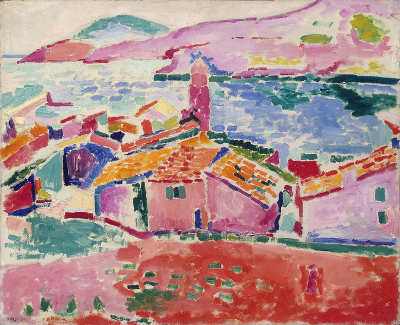
Henri Matisse - rooftops at Collioure - St. Petersburg, the Hermitage
Les Nabis
At the same time as Matisse, other French artists were moving forward along other roads to innovation opened up by the Impressionists. Strongly inspired by the light and colour of Impressionism, but also by Japanese art which had been "discovered" in France in the late 19th century, a group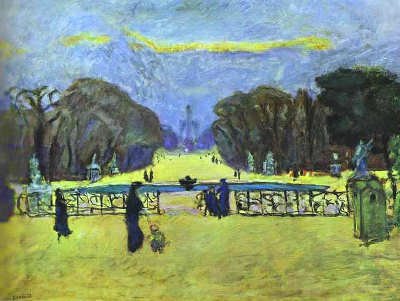
Pierre Bonnard - Jardin des Tuileries
With the Nabis, pictorial representative art, with its roots in Impressionism, continued well into the 1920's, becoming almost conservative when compared with other far bolder innovations that took French art forward in the first quarter of the 20th century.
Fauvism

Albert Marquet - The Bay of Naples 1909
Like Impressionism, Fauvism was not a school, but a coming-together of like-minded innovating painters showing a way forward away from photographic or representative depiction, faithful or distorted, towards new forms of art; bold colours, intense blacks, dark lines and often distorted forms. While Fauvist art may seem rather tame compared to other exuberantly wild and unconventional styles of painting that followed in the course of the 20th century, at the time it was very avant-garde.
Since the start of the Romantic movement in art, in the 1820s, moral and academic restraints on innovation and imagination had been progressively whittled down and eventually banished. Now, in the years that preceeded the First World War, innovation was rife and encouraged, nothing seemed impossible, and in the world of art, originality became a quality in a way it had rarely been before.
And on towards Cubism
From 1907 onwards, Braque and Picasso were opening the gates to Cubism; while not yet abstract art, their work from before the First World War was moving swiftly towards that goal. However much af a departure it was from even the most progressive figurative art of the period, Picasso's ground-breaking Demoiselles d'Avignon, painted in Barcelona in 1907, but first shown in Paris in 1916, was still figurative art, Paris, by 1910, was undisputably the world capital of innovation in art, but not quite ready for the seismic changes that would redefine the nature, the role and the paradigm of art after the trauma of the First World War.Between the two world wars, the internationalisation of art movements continued apace. Dada, Surrealism and other movements blossomed in France, but they were international, not specifically French. Artists like Pierre Soulages, though French and working in France, found their following, and their markets, worldwide. And today, in the twenty-first century, "French" art, as a distinctive genre, survives in the mind, and in the tourist guides. The Montmartre village in Paris, once home to artists like Raoul Dufy, Maurice Utrillo and Picasso, is now peopled with artists and painters from around the world. And barring something improbable and very unexpected, the last chapter in the story of specifically "French Art", has now been written.
Footnote
The Impressionists and their followers paved the way for the radical changes in "art" that took place in the course of the 20th Century, and the multitude of abstract and semi-figurative art styles that developed, from Cubism and beyond. It is important however to put things in perspective. The large majority of artists in France at the time were not Impressionists, nor innovators. While the Impressionists and Post-Impressionists pioneered new ways in art, and over time mainstream art followed them, most of their contemporaries continued to produce traditional representative figurative art, social art and portraits. Many of them were, in technical terms, superb artists, painters like Firmin-Girard or Lucien Doucet – well known at the time, but more or less unknown today. The history of art is the story of the innovators, the pioneers: those who do not innovate tend to be forgotten, often unjustly, however good they may have been.Where to see turn-of-the-century art in France
Art production in France at the turn of the century was prolific, and many French museums and art galleries have good collections of works from this period. Among those particularly worth visiting are.- Paris: Musée d'Art Moderne de la Ville de Paris (at the Trocadero) and Musée d'Orsay
- Le Cateau near Cambrai - Musée Matisse -
- Roubaix - Musée de la Piscine -
- Le Havre - Musée Malraux
- Besançon - Musée des Beaux Arts
- Bagnols-sur-Cèze - Musée Albert André
- Grenoble - Musée des Beaux Arts
- Albi - Musée Toulouse Lautrec
- Céret - Musée d'Art Moderne
- Le Cannet (French Riviera) - Musée Bonnard
- Nice : Musée Matisse
The About-France.com guide to art in France :
- Art and architecture in Medieval France
- French art in the Renaissance
- From Baroque to Rococo - the Grand Siècle and the Age of Enlightenment
- French art in the age of Revolution Neoclassicism to Romanticism
- Naturalism and realism
- Impressionism
- The legacy
of Impressionism
Website
copyright © About-France.com 2003 - 2025
Photos: all photos on this page are in the public domain.
Photos: all photos on this page are in the public domain.
About-France.com
Home
page - Site
search
- Regions
- Maps of France
- Contact
Photo top of page : Paul Signac - Herblay,
sunset. Glasgow, Kelvingrove gallery.

Georges Seurat - the Eiffel Tower
Fine Arts museum - San Francisco
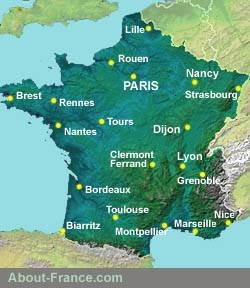
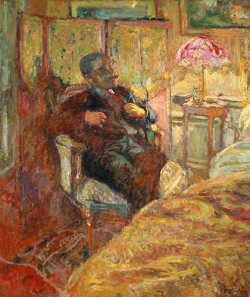
Vuillard - Portrait of Romain Coolus - Paris, Musée d'Orsay
Photos: all photos on this page are in the public domain.
About-France.com is a fully independent website affiliated to certain online booking platforms, and may receive a small commission only on bookings made through affiliate sites . This has no effect at all on the price paid by the visitor.
Copyright texts © About-France.com
After Impressionism- 1890
- 1910
The Impressionist movement was short lived; but its consequences are still with us today. It changed the course of art for ever, starting in the final years of the nineteenth century, when new generations of artists built on the new foundations and took painting into new uncharted territory. It was still figurative art, but the Cubism and abstract art were not far away.
The Impressionist movement was short lived; but its consequences are still with us today. It changed the course of art for ever, starting in the final years of the nineteenth century, when new generations of artists built on the new foundations and took painting into new uncharted territory. It was still figurative art, but the Cubism and abstract art were not far away.

Georges Seurat - the Eiffel Tower
Fine Arts museum - San Francisco

| ►► Site guide |
| About-France.com home |
| Full site index |
| About-France.com site search |
| ►► Principal chapters on About-France.com : |
| Guide
to the
regions of France Beyond
Paris, a guide to the French regions and their tourist attractions.
|
| Guide
to Paris Make
the most of your trip to Paris; Information on attractions, Paris
hotels, transport, and lots more.
|
| Accommodation
in France
The different options, including hotels,
holiday gites, b&b, hostels and more
|
| Tourism
in France
The
main tourist attractions and places to visit in France - historic
monuments, art galleries, seasides, and more
|
| Planning
a trip to France
Information
on things to do before starting your trip to France.
|
| Driving
in France
Tips
and useful information on driving in and through France - motorways,
tolls, where to stay....
|
| Maps
of France
Cities,
towns, departments, regions, climate, wine areas and other themes.
|
| The
French way of
life
A mine of information about
life and living in France, including
working in France, living in France, food and eating, education,
shopping.
|
| A-Z
dictionary of France Encyclopedic
dictionary of modern France - key figures, institutions, acronyms,
culture, icons, etc.
|
| ►► More accommodation |
| Gites in France |
| Bed & breakfast in France |
| Small rural campsites |
| Small hotels in France |

Vuillard - Portrait of Romain Coolus - Paris, Musée d'Orsay
Photos: all photos on this page are in the public domain.
About-France.com is a fully independent website affiliated to certain online booking platforms, and may receive a small commission only on bookings made through affiliate sites . This has no effect at all on the price paid by the visitor.
Click here for
low-cost car hire in France
low-cost car hire in France
Copyright texts © About-France.com
